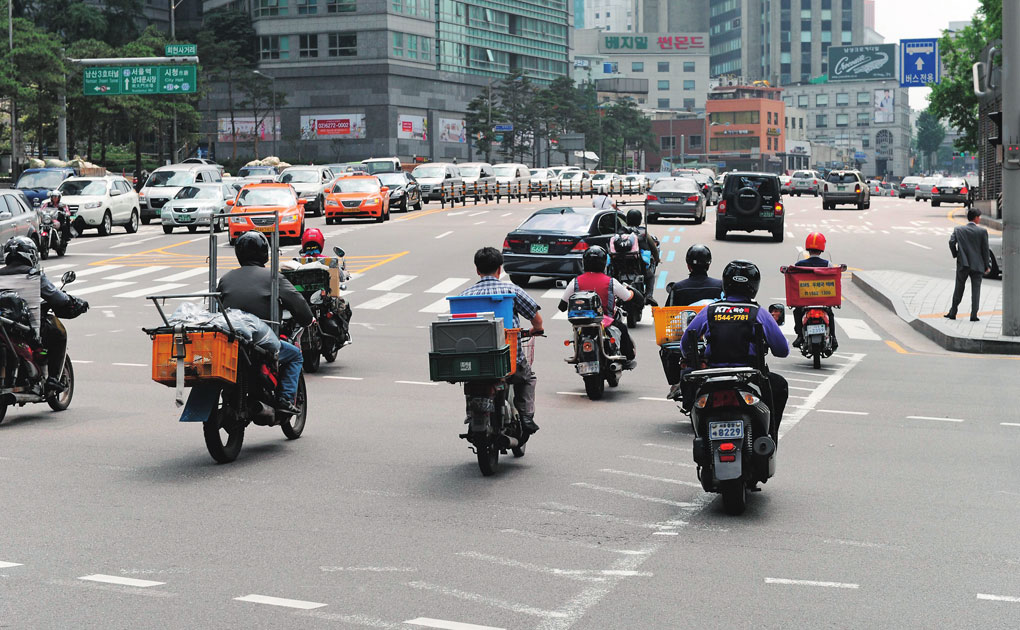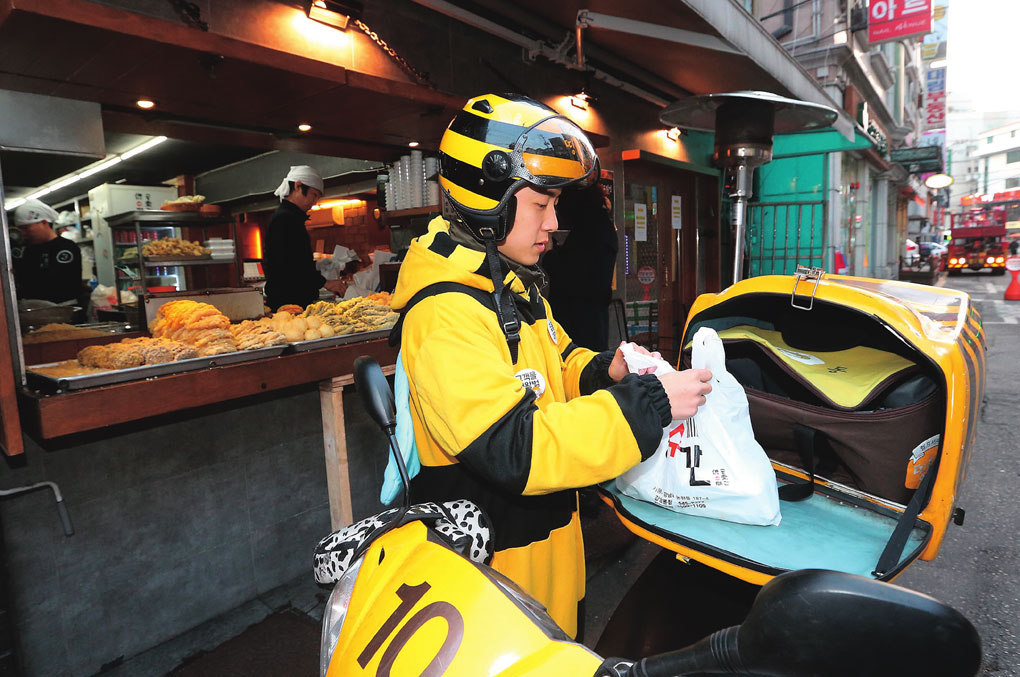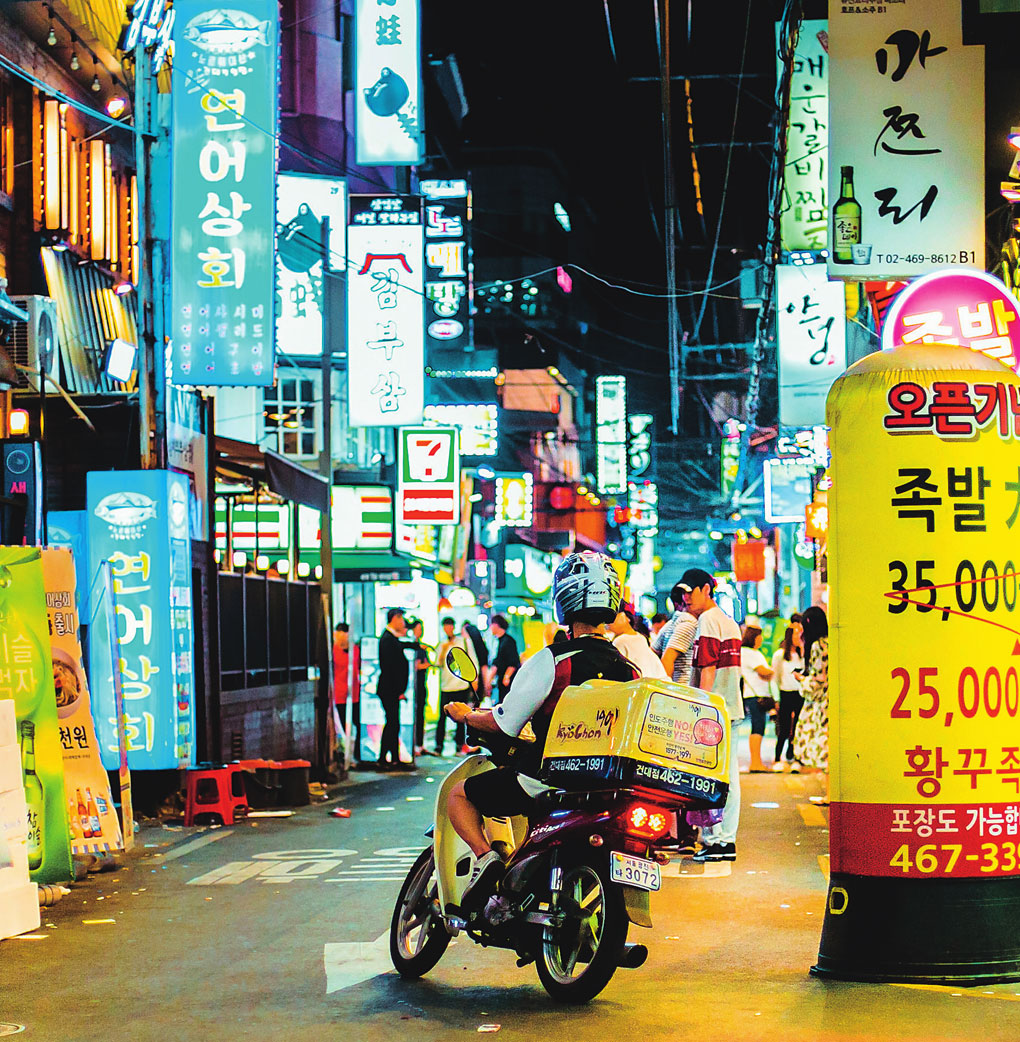A congested crossroads. As soon as the light turns green, dozens of motorcycles take off at breakneck speed before the other cars can rev up their engines. This is a common sight on the streets in Korea’s large cities. Hundreds of thousands of delivery workers brave risks every day to bring packages, be they food or other commodities, as quickly and safely as possible to customers.
Before I debuted as a novelist, I delivered Korean food in an office district in Seoul. I’ve also delivered for a Chinese restaurant in an entertainment district and a pizzeria in a residential area. Even during my short stay in London, I did a brief stint as a delivery boy for a Japanese restaurant. So I guess that makes me “a deliveryman with international experience.” But that turned out to be utterly useless when I came back to Korea, the emerging powerhouse of delivery service. In Britain, delivery is considered a proper job, whereas in Korea, it’s often just a temporary gig.

Delivery riders are often seen dashing through rush hour traffic. In order to make as many deliveries as possible in a limited time, they need to know the streets like the back of their hand and plan the most efficient route. © NewsBank
Dilemma
“The long-haired guy next door has been hospitalized. Did you know?”
I was preparing for the day’s work when my boss, looking sad, told me the unfortunate news. The long-haired guy was a highly proficient “master.” Whenever I came across him on the streets, I would be amazed at his skill. He looked like a pro racer. I had gotten wind that he was heartbroken from a relationship recently gone awry. And now, this… Just goes to show that a delivery man needs to stay and focused at all times, like a surgeon, analyst or pilot. Take your eyes off the road for a split second and you could find yourself sprawled on the ground.
During my delivery rounds, there were times when I felt a chill run down my spine even in the scorching heat of summer. I’d catch sight of a motorcycle placed carelessly on the side of the road – one that had obviously not been parked there. Looking closer, the spoke wheel would be bent or the side horribly scraped. The bike would have been moved to the side to clear the road after the rider was taken away in an ambulance. Delivery accidents happen too often. If a person I usually ran into every day was nowhere to be seen, it meant he was either injured or dead.
“You should be more careful about speeding. Stop racing round like a madman, okay?”
My boss was worried about my riding style.
“I’m fine. I’ve got nothing to lose anyway.”
“Cut the nonsense. I can’t lose you. So make sure you ride safely.”
It was heartwarming, but also a very realistic piece of advice.
Anyone can work as a motorcycle courier, as long as you have a license and no fear. Depending on the number of runs a day, you can earn quite a handsome income. Additionally, you don’t have to deal with the stress of a rigid office culture or stuffy boss. Nonetheless, motorcycle couriers are in short supply. The biggest drawback is that it is a perilous job. There are too many idiots on the road, and, in Korea, where it’s much too easy to get a driver’s license, delivery workers constantly face the danger of being hit by a beginner.
Riders risk their lives driving full throttle for faster delivery and better pay. Motorcycle accidents happen in the same way that road kills do. Sadly, many riders believe that their motorcycles are faster than cars. Motorbikes may seem more agile because of their smaller size, but they are neither faster nor more powerful. However, playing it safe and slowing down means less money. The only way out of this precarious dilemma is hitting the jackpot. I can safely bet that almost every delivery rider has a lottery ticket in their pocket.

A deliveryman for Ddingdong, which services the Gangnam district in Seoul, loads an order from a snack food restaurant on his scooter. Small restaurants that can’t afford their own delivery workers use delivery platforms. © NewsBank
Know-How
It’s 11 a.m. The phone starts ringing off the hook. During the two-hour window at lunchtime, every rider has to make around 30 delivery runs. Each delivery takes on average five minutes, which means 12 per hour and 24 in two hours. But there are many places that take more than five minutes, so we have to make multiple deliveries at once. This is also why a good sense of space determines the competence of a delivery worker. We an image in our mind of the shortest route connecting the delivery addresses. You have to use your head. There is only so much you can load on a motorcycle and only so fast you can go. A true pro is someone who can picture a clear-cut, efficient route in their head.
Another requisite is a shrewd grasp of traffic conditions. You need to know when the traffic light at the intersection in front of the store changes, and quickly judge whether it will be faster to take the stairs or elevator before arriving at your destination. A skilled courier sharpens his sixth sense to predict what will shoot out from the next alley and whether the car coming from the other side is going to make a U-turn. A master feels a sense of fulfillment when successfully pulling off a task where others fail.
I head out for my destination. I hope that the car in front of me doesn’t violate a traffic signal, that a bicycle doesn’t suddenly come out of nowhere like a deer, that I don’t hit someone, that my motorcycle doesn’t skid on a banana peel, that it doesn’t hit a pothole, throwing me into a somersault in the air. I pray again and again. Anyhow, I have to survive and continue to live. But once I get going, I have only one thought in my mind: don’t arrive late and get yelled at by the customer!
You have to use your head. There is only so much you can load on a motorcycle and only so fast you can go.
A true pro is someone who can picture a clear-cut, efficient route in their head.
Indignity

A chicken franchise deliveryman passes through a restaurant alley in the Konkuk University area, eastern Seoul, late at night. © Shutterstock; Photo by Kelli Hayden
My first delivery is to an office where the people are obnoxious. They always talk down to me, and curse if I’m the slightest bit late. They seem to have a vulgar sense of superiority, thinking that people working in manual jobs, such as delivery, are of a lower social class and deserve to be treated crudely. I flip out whenever I go to collect the plates.
“I asked you not to put trash in the plates.”
No one even bothers to respond. They treat me as if I’m invisible. They don’t even pay me right away. Instead, they keep a monthly ledger of their orders. When I ask for their signature, they deliberately take their time, as if they were signing off on a major payment, and at times, order four portions, then sneakily write down three. When I go to collect at the month’s end, they have the nerve to yell at me.
“For Pete’s sake, we said we’d pay later. You think we would cheat you out of that petty sum? Huh?”
One day, the people at that office fled without paying up. Livid, my boss and I tried to hunt down those weasels, but to no avail. These days, prepayments are made online or through an app, preventing such mishaps. In that sense, technological advances are a godsend.
My next delivery is a factory. The place is filled with frenetic activity. I wonder if they even have time to eat. As I leave, I notice that the workers all have bloodshot eyes. My eyes are red too, from all the fumes and dust on the road. I don’t have time to waste comparing who is more pitiful, them or me. I rush to my next stop, a motel, when it starts to pour. I can practically hear the sound of the phone ringing like crazy back in our restaurant – orders spike in bad weather.
I take out my raincoat and put it on and even wrap a towel around my neck, but it’s not enough to keep the rain out. The rain stings, hitting my body as I speed along; it feels sad. Drenched and pitiful, I drag my heavy feet, soggy with water, and enter the motel. A man with only a towel wrapped around his naked body opens the door and takes the food. He must have ordered out because he couldn’t be bothered to get dressed. That’s the spirit. I wish him to rest more and love more instead of wasting time getting dressed. As I make my way back to the restaurant to load the next round of deliveries, I hope that his life will be less hectic, that his quality of life improves, and that my life could be like that, too.
Balance
Back at the restaurant, the dishes waiting to be delivered are growing cold. I quickly load the food and hit the road again. People don’t order out for food because it tastes good. You can hardly expect food in a plastic bowl covered with plastic wrap that gets all bumped around in a delivery box to taste better than a warm dish prepared by a chef at a nice restaurant, beautifully plated and served by a friendly waiter. Nonetheless, people get food delivered because it’s more convenient than going to a restaurant or waiting in line. Of course, some people don’t have a sensitive palate and aren’t particular about taste.
However, food deliveries have led to a huge increase in the use of disposable packaging, a major source of microplastics pollution. One question after another pops up in my mind. Is a culture where anything can be delivered anywhere, anytime something to be proud of? Is a thriving delivery industry associated with a higher quality of life? Is there an upside to Korea’s advanced home delivery culture other than the relief of knowing that, at the very least, you won’t starve to death even if you can’t go outside because of the coronavirus pandemic? I mean, there’s a high chance that your food will be brought by someone who is irritable because he is always pressed for time, and sick and tired of being put down. Does the sole benefit of having food delivered to wherever you are eclipse all the other numerous drawbacks? More than anything, is it okay to disregard the environment for the sake of convenience?
Delivery motorcycles wind their way through narrow alleyways to avoid traffic jams. With no designated parking areas, these bikes can be parked pretty much anywhere in Korea, even on sidewalks and crosswalks. Riders have no qualms about committing traffic violations, often ignoring traffic signs and even driving against traffic. Because motorcycles are not easily visible in the side mirrors of cars, riders announce their presence with thunderous exhaust sounds and startle other motorists by riding erratically. It’s virtually impossible to make a food delivery on time while observing all traffic rules.
But delivery riders don’t have the luxury to even think about such matters. We instinctively sense that someone is eagerly waiting for us with a growling stomach. So we focus – and ride at full speed. My last delivery for the day is to a company having an office party. It’s a large order and my motorcycle wobbles when I load all the food. When I get there, a cheerful bunch of people greet me enthusiastically. They are leisurely toasting each other under a congratulatory placard. They all look happy, as if they have accomplished something together. Making deliveries to a place like this makes the job a tad rewarding. As I leave, someone comes up to me and hands me a tip, politely saying, “It was a big order, wasn’t it? It must have been heavy. Thank you for delivering it in the rain.” The tip and kind words relieve the day’s fatigue.
The day is finally over. It was a long one. My neck and shoulders are stiff and worn like beef jerky from wearing the heavy helmet and riding all day, my hands are wrinkly from being soaked in the rain, and my arms and legs are limp from rushing up and down the stairs countless times. I need to make one last delivery: taking my tired body home and laying it down on my cozy bed. I whistle a tune as I start my motorcycle.
Park SangNovelist